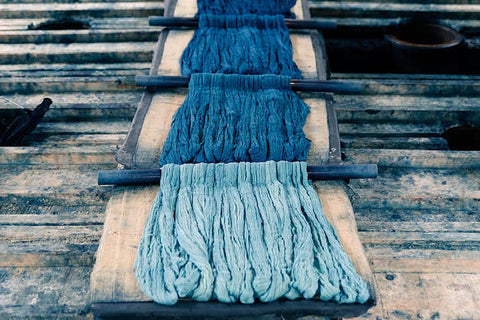
Do you know about indigo dyeing? When the emblem for the 2020 Tokyo Olympics was announced, I think you'll hear more about the word indigo dyeing.
Indigo dyeing is a traditional hand dyeing method that has been passed down since the Asuka period using indigo leaves, which are a plant in the Octopus family. The unique blue color created by indigo dyeing is called indigo and is a color that symbolizes Japan. It is also used as the emblem of the 2020 Tokyo Olympics, and is known overseas as "Japan Blue." The name comes from a book written by Robert William Atkinson, a British chemist who came to Japan in 1875 (Meiji 8), mentioning that Japanese towns at the time were colored indigo. It is said that this phenomenon was expressed as ``Japan Blue'' in ``Indigo theory.''
[Difference between indigo dyeing and indigo dyeing]
I think there is an impression that indigo dyeing is rarer and more expensive than indigo dyeing, which has a similar tone. The big difference is
Indigo dyeing: Dyeing using natural dyes, which requires manual labor and cannot be mass produced.Indigo dyeing: Dyeing using artificial dyes, mechanized and mass production possible.
Indigo dyeing begins with making the dye from indigo leaves, and requires a huge amount of time and the skills of skilled craftsmen to finish dyeing.As it is individualized and cannot be mass-produced, it is inevitable that there will be a small number of products available. The price will be higher than dyed.

Indigotine, the pigment in indigo, is insoluble, so unlike other vegetable dyes, the pigment cannot be extracted by methods such as boiling. For this reason, craftsmen called Aishi ferment the indigo leaves for about 100 days using microorganisms attached to them to create a dye called ``Sukumo.'' Mix it with alcohol, lye, etc. and ferment it inside the turtle to complete the dyeing solution. As the ``Sukumo'' matures in this liquid, the indigo color becomes darker, but if it ferments too much, it will rot, so many years of experience are required to create a well-balanced dyeing liquid. In addition, the dyeing process itself is often done by skilled craftsmen and takes a long time.
[History of indigo dyeing]
Indigo dyeing has become a Japanese tradition over a long period of time.

Indigo dyeing came to Japan from China in the 700s and was used to dye kimonos and local costumes. Indigo dyeing developed in villages near rivers because large amounts of water were needed to produce good indigo dyeing. In the 1500s, indigo dyeing became a major industry in Tokushima Prefecture, which was blessed with the perfect environment for indigo dyeing. However, in the early 1900s, the artificial dye indigo was introduced to Japan, and indigo dyeing became sluggish due to its lack of productivity. After that, during World War II, government directives forced indigo fields to be converted to edible plants, and indigo cultivation almost disappeared. Although the indigo dyeing industry was on the verge of extinction, the craftsmen of Tokushima Prefecture secretly continued indigo dyeing, and the indigo dyeing industry has been passed down to the present day.
[Charm of indigo dyeing]
Indigo dyeing has been loved by the Japanese for over 1000 years. Introducing the appeal of indigo dyeing, which continues to fascinate Japanese people.

The most attractive feature of indigo dyeing is the unique, bright blue color that can only be produced by indigo dyeing. Indigo dyeing changes the shade of blue depending on the number of times it is dyed, resulting in colors such as ``Kamenozoki,'' ``Asagi,'' ``Nando,'' ``Ai,'' and ``Kachiiro.'' There are many blue colors. In addition, since indigo dyeing does not use any chemicals, it is gentle on the skin, is an environmentally friendly dyeing method, and can also be used to support the SDGs, which have been attracting attention recently. In addition, it has the effect of repelling insects, is breathable and cool in the summer, and retains heat and keeps you warm in the winter, so it is good to look at, good to wear, and environmentally friendly.
[Indigo dyeing process]
Indigo dyeing involves fermenting indigo leaves over a long period of time to create a ``sukumo'', which is then used to create a dye solution. The subsequent dyeing process is also a time-consuming process, as the dyeing is done by hand, in small batches, by craftsmen rather than machines. We will introduce the dyeing process of indigo dyeing using T-shirts as an example.

As the first step, indigo dyeing takes time to make the Sukumoya dyeing solution, but the actual dyeing process is also done by hand, in small quantities, by craftsmen rather than machines, so it takes time to finish the dyeing. . We will introduce the dyeing process of indigo dyeing using T-shirts as an example.
The first step is to wash the fabric thoroughly with water to remove any protein that may have adhered to it.

Next, soak the T-shirt in the indigo dye solution and massage the dye thoroughly.

When you take it out of the dyeing solution, it looks dark green at first, but this is the green of the indigo leaves. When you squeeze out the excess dye soaked into the fabric, the dye oxidizes and turns into a beautiful blue color. The more times this process is repeated, the more intense the blue hue becomes.

I dyed the T-shirt below 1-4 times. These colors of love were called Asagi (left), Nando (center left), Kachiiro (center right), and Shikon (right).

Once you've achieved the blue you're aiming for, use vinegar to alkalize and soften the color.
Finally, rinse well, dehydrate, and dry in the shade for a day.


